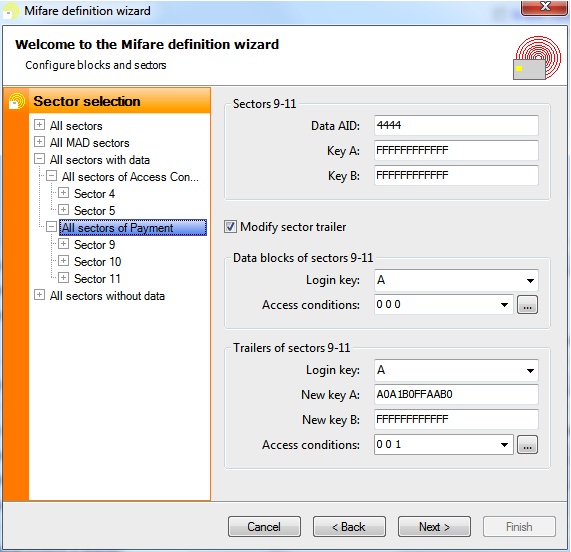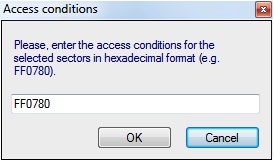

The navigator object on the left-hand side shows all blocks and sectors grouped in various ways and in a hierarchical manner. It allows the user to select a single data block, but also entire sectors and groups of sectors. On the right-hand side the settings for the selected sector or group of sectors and the selected block or group of blocks can modified, and can be viewed provided that all sectors or blocks in the group share the same setting. If any modification is done, it will apply to all selected sectors and blocks. For example, if in the above screen shot the access conditions are changed for the data blocks, this setting will apply to all data blocks of sector 10. After that, it is possible to select block 0 of sector 10 and change the access conditions for this block only, without affecting blocks 9 and 11. In general, it is advisable to start a definition with settings shared by many blocks and work down to the exceptions to the general rule.
The first group of settings are defined on the sector level and contain the keys to be used to logon to the sector(s). The keys are entered in hexadecimal format. If the fields do not contain a valid hexadecimal string or contain the wrong key values, processing the definition will result in an error. If one of the keys is not used, it is not necessary to enter a specific value and the default value FFFFFFFFFFFF can be left unchanged. This group also contains a field called Data AID, that can only be edited when the selected sectors are referred to by one or more data items and when you are reading and updating the MAD automatically. This is the so-called Application Identifier, which is defined on a sector level to allow for optimal flexibility. It should be noted, however, that the Data AID essentially refers to the data of the Data Items defined for that sector and not to the sector itself. CardExchange® Producer might be allowed to write application data to another sector than specified in the definition.
If one of the selected data blocks is the target of a Data Item, it has to be indicated whether the logon to the sectors of those blocks is to be done with key A or key B. This is a property that can be set for each block individually and is therefore found in the second group of settings, which contains all block-level settings.
Between the sector-level and the block-level properties, a check box allows the user to indicate whether he wants to modify the sector trailers of the selected sectors. If any of those has a trailer that will be written to by a Data Item, this option cannot be selected. Otherwise, the user should provide the necessary information for writing to the sector trailers, which is: the key to be used to logon to the sector before writing the sector trailer, the new key values to be written and the access conditions for both the data blocks and the sector trailer itself to be written.
The login key for the sector trailers, the new key values and the access conditions for the sector trailers are grouped in the third block of settings, which contain all trailer-level settings.
The access conditions for the data blocks can be set for each block individually on MIFARE® Classic 1K. For MIFARE® Classic 4K, the access conditions are shared between five data blocks and cannot be set for individual blocks. The small buttons  right of the combo boxes allow the access conditions to be entered in hexadecimal format.
right of the combo boxes allow the access conditions to be entered in hexadecimal format.

Setting the access conditions this way will always affect all blocks of the selected sector, even if only one of those blocks has been selected. A six-digit (three-byte) hexadecimal string that represents a valid set of access conditions should be entered. Byte nine of the sector trailer is not considered to be part of the access conditions and will always be set to zero, except for sector 0 if MAD is used.
Click Next to proceed with the creation of the Classic Definition and go to Step 5.
